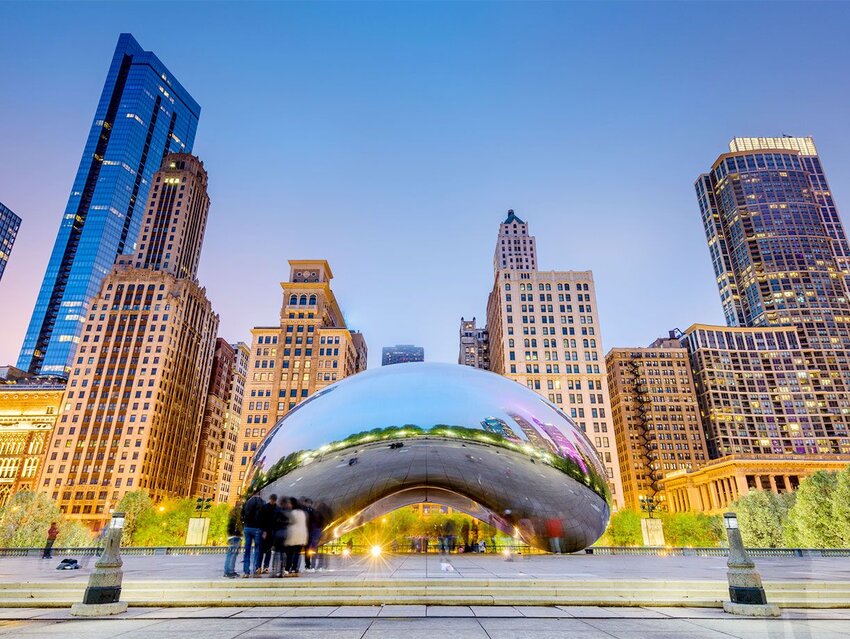Big-name architectural landmarks offer bucket-list experiences. The allure of structures like the Colosseum and the Arc de Triomphe is unmistakable, but some of these world-famous monuments don't go by their real names. “The Bean,” for example, has a more fanciful label, and the Statue of Liberty has a more official title. These better-known monument nicknames can be found around the world, from England and France to Egypt and China. Do you know the real names behind these famous monikers?
The Bean: “Cloud Gate”
In the case of Chicago’s famous “bean,” this structure’s legume-inspired nickname actually came first. Before British artist Sir Anish Kapoor had the chance to title his work, locals began referring to the reflective sculpture as “The Bean” because of its distinctive curvy shape. After its unveiling in Millenium Park in 2004, Kapoor named the structure “Cloud Gate” because 80 percent of its surface reflects the sky above.
Big Ben: “Elizabeth Tower”
Technically, “Big Ben” is only the massive 13-ton bell inside of the 19th-century clock tower overlooking London’s Houses of Parliament. But the tower itself is “Elizabeth Tower,” named after Queen Elizabeth II in 2012. Prior to this naming, the tower was simply the “clock tower,” so naturally people tended to call the whole thing “Big Ben.” The original Ben is unknown, but a few possibilities include Sir Benjamin Hall (a prominent civil engineer) or possibly heavyweight boxing champion Benjamin Caunt.
The Statue of Liberty: “Liberty Enlightening the World” or La Liberté Éclairant le Monde
Lady Liberty is one of America’s greatest and most well-known monuments. The statue was given as a gift to America from France in 1885 to celebrate the enduring friendship that began during the American Revolution. Upon gifting the masterpiece designed by Frederic Auguste Bartholdi and Alexandre Gustave Eiffel to America, the statue was named “Liberty Enlightening the World” (La Liberté Éclairant le Monde), but the statuesque female form inspired the more simple nicknames of “Statue of Liberty” and “Lady Liberty.” The statue was constructed at Fort Wood on Bedloe Island, which is now known as Liberty Island, in New York Harbor.
Arc de Triomphe: “Triumphal Arch of the Star” or Arc de Triomphe de l'Étoile
The Arc de Triomphe, or “Victory Arch” in English, was commissioned by Napoleon I in 1806, and over 200 years later, it’s still one of the most-beloved monuments in the City of Light. The arch is located on the Champs-Élysées, one of the most recognizable streets in Paris, and surrounded by a busy traffic circle called Place Charles de Gaulle. Historically, this traffic circle was called Place de l'Étoile — l’etoile meaning “the star” for its many intersecting points. While the shorthand name of l’Arc de Triomphe is instantaneously recognizable and brings to mind that small area of Paris, historically, the arch was known as Arc de Triomphe de l'Étoile.
The Colosseum: “Flavian Amphitheater”
By definition, a “colosseum” (or “coliseum”) is any large theater or stadium. Found in Rome, one of the world’s most famous landmarks goes by this name. Builders began construction on The Colosseum around 70 BCE during the Flavian dynasty (under emperors Vespasian, Titus, and Domitian), from which it gained its original name. The massive amphitheater seated some 50,000 spectators for a variety of events, including gladiator battles.
The Great Wall of China: Wanli Changcheng or Chang Cheng
Regarded as one of the world’s greatest architectural undertakings, the Great Wall of China is known to the Chinese as Wanli Chancheng, which roughly translates to “10,000-Li Long Wall." The “li” is a unit of Chinese measurement that is equal to 500 meters (about 1,640 feet). The wall itself is around 13,000 miles long. Another Chinese name of Chang Cheng, which translates to “long wall,” appeared in a history book from the Han dynasty (around 200 BCE - 200 CE) and remains in use as well.
Great Pyramid of Giza: “Horizon of Khufu” or Akhet Khufu
The aptly named Great Pyramid of Giza is the largest of the ancient Egyptian pyramids. This structure was commissioned by the pharaoh Khufu, with construction beginning in 2550 BCE. The ancient Egyptians referred to the pyramid as Akhet Khufu, which means “Horizon of Khufu.” Khufu's pyramid is also the oldest at Giza. The other two pyramids were built in the following years by the pharaohs Khafre (Khufu’s son) and Menkaure. While the “Great” pyramid is the most well known at Giza, the names (by descending size) are Khufu, Khafre, and Menkaure.
Featured image credit: Sean Pavone/ iStock

